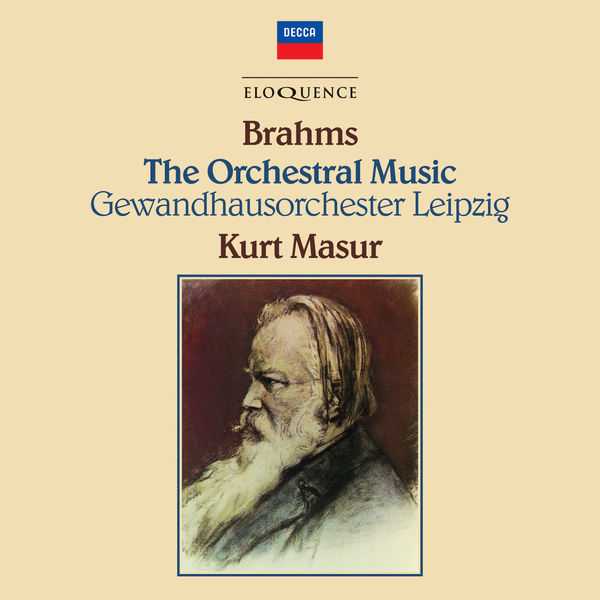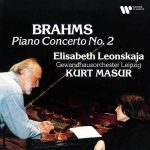
Composer: Johannes Brahms
Orchestra: Gewandhausorchester Leipzig
Conductor: Kurt Masur
Format: FLAC (tracks)
Label: Decca
Release: 2019
Size: 2.19 GB
Recovery: +3%
Scan: cover
Symphony No. 1 in C minor, Op. 68
01. 1. Un poco sostenuto – Allegro – Meno allegro
02. 2. Andante sostenuto
03. 3. Un poco allegretto e grazioso
04. 4. Adagio – Piu andante – Allegro non troppo, ma con brio – Piu allegro
05. Variations on a Theme by Haydn, Op. 56a
Symphony No. 2 in D major, Op. 73
06. 1. Allegro non troppo
07. 2. Adagio non troppo – L’istesso tempo, ma grazioso
08. 3. Allegretto grazioso (Quasi andantino) – Presto ma non assai
09. 4. Allegro con spirito
Symphony No. 3 in F major, Op. 90
10. 1. Allegro con brio – Un poco sostenuto – Tempo I
11. 2. Andante
12. 3. Poco allegretto
13. 4. Allegro
Symphony No. 4 in E minor, Op. 98
14. 1. Allegro non troppo
15. 2. Andante moderato
16. 3. Allegro giocoso – Poco meno presto – Tempo I
17. 4. Allegro energico e passionato – Più allegro
18. Academic Festival Overture, Op. 80
19. Tragic Overture, Op. 81
Violin Concerto in D major, Op. 77
20. 1. Allegro non troppo
21. 2. Adagio
22. 3. Allegro giocoso, ma non troppo vivace – Poco più presto
Concerto for Violin and Cello in A Minor, Op. 102
23. 1. Allegro
24. 2. Andante
25. 3. Vivace non troppo – Poco meno allegro – Tempo I
Piano Concerto No. 1 in D minor, Op. 15
26. 1. Maestoso – Poco più moderato
27. 2. Adagio
28. 3. Rondo (Allegro non troppo)
Piano Concerto No. 2 in B-flat major, Op. 83
29. 1. Allegro non troppo
30. 2. Allegro appassionato
31. 3. Andante – Più adagio
32. 4. Allegretto grazioso – Un poco più presto
Serenade No. 1 in D major, Op. 11
33. 1. Allegro molto
34. 2. Scherzo (Allegro non troppo) – Trio (Poco più moto)
35. 3. Adagio non troppo
36. 4. Menuetto I-II
37. 5. Scherzo (Allegro)
38. 6. Rondo (Allegro)
Serenade No. 2 in A major, Op. 16
39. 1. Allegro moderato
40. 2. Scherzo (Vivace)
41. 3. Adagio non troppo
42. 4. Quasi menuetto – Trio
43. 5. Rondo (Allegro)
21 Hungarian Dances, WoO 1 – Orchestral Version
44. No. 1 in G Minor
45. No. 2 in D Minor
46. No. 3 in F Major
47. No. 4 in F-Sharp Minor
48. No. 5 in G Minor
49. No. 6 in D-Flat Major
50. No. 7 in A Major
51. No. 8 in A Minor
52. No. 9 in E Minor
53. No. 10 in E Major
54. No. 11 in A Minor
55. No. 12 in D Minor
56. No. 13 in D Major
57. No. 14 in D Minor
58. No. 15 in B-Flat Major
59. No. 16 in F Minor / Major
60. No. 17 in F-Sharp Minor
61. No. 18 in D Major
62. No. 19 in B Minor
63. No. 20 in E Minor
64. No. 21 in E Minor
Kurt Masur’s burnished readings of Brahms’s orchestral music with the Gewandhausorchester Leipzig
Hardly less than with its founder, Felix Mendelssohn, the Leipzig Gewandhaus grew up with Brahms conducting and playing. For a sense of heritage, the orchestra boasts a Brahms tradition second to none. In the words of Kurt Masur, their Kapellmeister for over a quarter of a century, ‘if they play Brahms, you can say it’s still authentic’.
Eloquence has compiled the Brahms recordings they made together between 1973 and 1981 for both the East-German Eterna label and Philips. Together they form the most comprehensive documentation yet issued of a musical relationship between composer, conductor and ensemble that was uniformly distinguished by deep understanding and affection. From the keyboard lion’s roaring of the First Piano Concerto to the rage and reconciliation of the Third Symphony and the mellow reflections of the Double Concerto, Masur and the Leipzigers present Brahms in the round.
‘Tradition is everything to the Gewandhaus,’ said Masur. ‘It’s what gives us our identity. It’s why we sound like ourselves and not like any other orchestra.’ The bedrock of that sound is a strong, unified string section with a density of timbre that supplies all the required weight for the post-Beethovenian drama of the First and Fourth symphonies. Masur maintained a narrow, brightly illuminated palette of wind tone-colours that lends a ruddy glow to the more pastoral tones of the Second as well as the rustic orchestrations of the Hungarian Dances and the oboe-led slow movement of the Violin Concerto.
The 1978 recording of the concerto finds its soloist Salvatore Accardo on his most honeyed and alluring form, contrastingly partnered in the Double Concerto by the gruffer, more outspoken tones of the cellist Heinrich Schiff. Masur and the Gewandhaus made several recordings of the piano concertos; Eloquence returns to the earliest and least-familiar of them, made with the American pianist Misha Dichter in 1977 when he was a peerless exponent of Liszt, in performances that grab the listener by the scruff of the neck and never let go.



